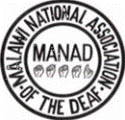Sign Language
The United Nations Convention on the Rights of Persons with Disabilities (CRPD) recognizes that both equality and the human rights of deaf people depend on their access to sign language – the right to acquire sign language as early as possible, to receive education through the medium of sign language, to access services in sign language and through professional sign language interpretation, and to be able to engage fully in society and in all spheres of life.
The history of sign language in Malawi dates back at least as far as deaf education in Malawi itself. The first school for the deaf in Malawi was established in Maryview in the Chiradzulu district in 1968, followed by another six schools for the deaf. Like other sign languages, MSL was not artificially invented by anybody, but has naturally emerged among deaf people within deaf communities and schools (see Johnston & Schembri 2007: 19). Some signs of MSL have possibly come from other sources, such as other sign languages, or signs or gestures that were used among family members at home.
Starting in 2017, the focus between the long-term cooperation of MANAD and FAD was set on Sign Language Dictionary Work and on the research and documentation of Malawian Sign Language. The Finnish Association of the Deaf has implemented development projects with various National Deaf Associations and deaf communities around the world for over 30 years. This work has mainly concentrated on organizational and management training, advocacy work, linguistic training, language re-
search through sign language documentation and description, and sign language interpreter training. Lessons learned from the cooperation, in particular with the Albanian Deaf Association since 2003 and Kosovar Deaf Association since 2006, are gathered in Working Together – Manual for Sign Language work within Development Work (FAD & WFD 2015). Following the guidelines set by the World Federation of the Deaf and in accordance with CRPD, the Manual follows the ethical guidelines and examples of how to implement Sign Language Work in a sustainable way. The best practices and experience both from Albania and Kosovo and the spirit and main principles set out in the Manual were used while planning and conducting the work in Malawi, but naturally the context of the Malawian community, specific circumstances and culture were accommodated during all stages of the work.
In Malawi, the dictionary work involved the following stages: recruitment of SLW research assistants (SLWRAs) and SLW group (SLWG), training SLWRAs, practical dictionary work, validating signs with SLWG, and designing the dictionary layout. From the beginning, work for the project was conducted by Malawian deaf people themselves, with support from the deaf linguistic advisor from Finland.
Now that after three years of hard work, the first edition of the Malawian Sign Language dictionary is available, one must remember that the work is not complete. Even the vast data collected for this dictionary has not been completely analyzed and coded. MANAD and its stakeholders must ensure that dictionary work will go on, and that enough resources will be available to make the work sus-
tainable and successful.
